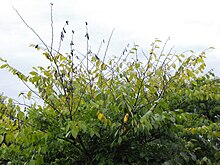Dutch Elm disease
| Dutch elm disease | |
|---|---|

Branch death, or flagging, at multiple locations in the crown of a diseased elm
|
|
| Common names | DED |
| Causal agents |
Ophiostoma ulmi Ophiostoma himal-ulmi Ophiostoma novo-ulmi |
| Hosts | elm trees |
| Vectors | elm bark beetle |
| EPPO code | CERAUL |
| Distribution | Europe, North America and New Zealand |
Dutch elm disease (DED) is caused by a member of the sac fungi (Ascomycota) affecting elm trees, and is spread by elm bark beetles. Although believed to be originally native to Asia, the disease was accidentally introduced into America and Europe, where it has devastated native populations of elms that did not have resistance to the disease. It has also reached New Zealand. The name "Dutch elm disease" refers to its identification in 1921 and later in the Netherlands by Dutch phytopathologists Bea Schwarz and Christine Buisman who both worked with Professor Johanna Westerdijk. The disease affects species in the genera Ulmus and Zelkova, therefore it is not specific to the Dutch elm hybrid.
The causative agents of DED are ascomycete microfungi. Three species are now recognized:
DED is spread in North America by three species of bark beetles (Family: Curculionidae, Subfamily: Scolytinae):
In Europe, while S. multistriatus still acts as a vector for infection, it is much less effective than the large elm bark beetle, S. scolytus. H. rufipes can be a vector for the disease, but is inefficient compared to the other vectors. S. schevyrewi was found in 2003 in Colorado and Utah.
Other reported DED vectors include Scolytus sulcifrons, S. pygmaeus, S. laevis, Pteleobius vittatus and Р. kraatzi. Other elm bark beetle species are also likely vectors.
...
Wikipedia
